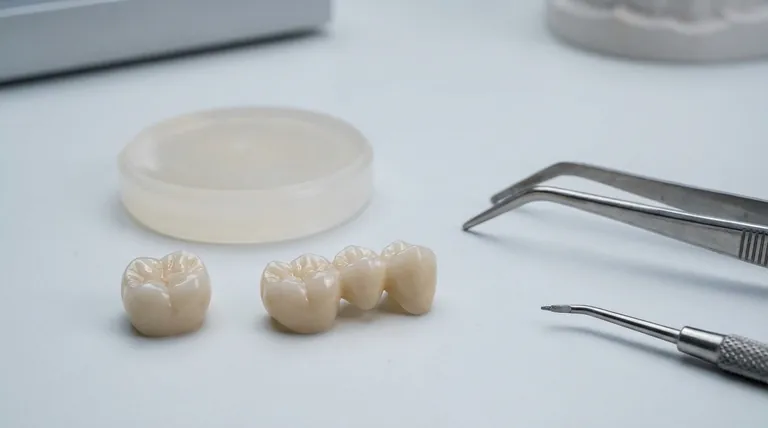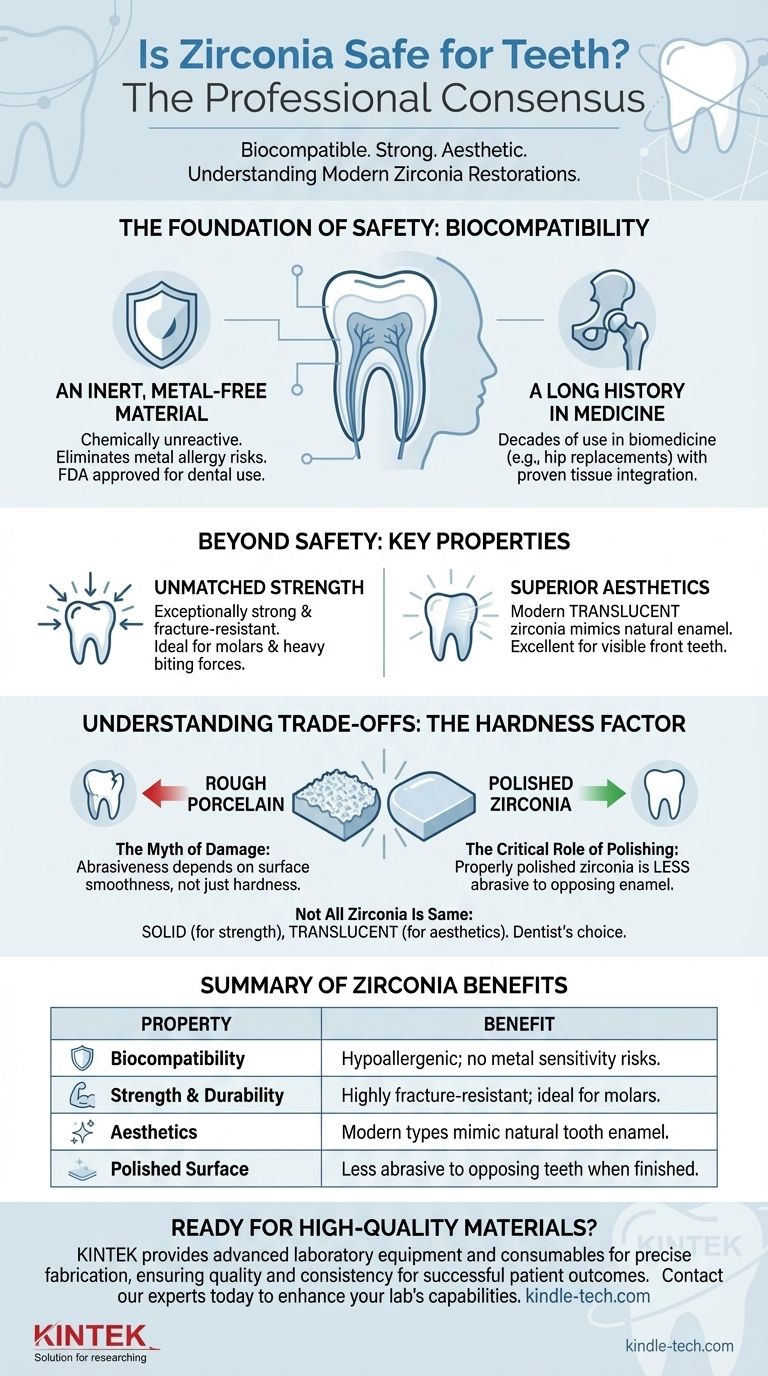In the world of modern dentistry, zirconia is overwhelmingly considered a safe and highly effective material for dental restorations. Backed by decades of use in medicine and extensive clinical research, it is an exceptionally biocompatible, ceramic material. This means your body is highly unlikely to have an allergic or inflammatory reaction to it, which is why it has earned full FDA approval for dental use.
While zirconia is one of the safest and most durable materials available for dental crowns and bridges, the key to a successful outcome is not its inherent safety, but a proper understanding of its hardness. The specific type of zirconia used and the skill of your dentist in polishing it are what prevent issues with opposing teeth.

The Foundation of Zirconia's Safety: Biocompatibility
At the core of any dental material's safety is its ability to coexist with the human body without causing harm. Zirconia excels in this area.
An Inert, Metal-Free Material
Zirconia, in its stabilized form (zirconium dioxide), is a ceramic. It is chemically unreactive and does not corrode or release substances into your body over time.
This is a critical advantage for individuals with known metal allergies or sensitivities, as it completely eliminates the risk of reactions often associated with the nickel or other metals found in porcelain-fused-to-metal (PFM) crowns.
A Long History in Medicine
Long before its widespread use in dentistry, zirconia was a trusted material for biomedical applications, most notably in prosthetic hip replacements.
Its proven track record for integrating with bone and tissue without causing adverse immune responses gave clinicians immense confidence in adapting it for dental restorations like crowns, bridges, and implant abutments.
Beyond Safety: The Key Properties of Zirconia
Zirconia's popularity isn't just about safety; it's about a unique combination of strength and aesthetics that solves many problems of older materials.
Unmatched Strength
Zirconia is exceptionally strong and resistant to fracture, far more so than traditional all-porcelain crowns.
This makes it an ideal material for restoring molars in the back of the mouth, where biting forces are the most powerful. It can withstand the immense pressures of chewing and grinding without chipping or breaking.
Superior Aesthetics
Early forms of zirconia were very strong but also very opaque, making them look less natural. However, modern dental technology has produced newer, translucent zirconia.
This material allows more light to pass through, giving it a depth and appearance that closely mimics natural tooth enamel. This makes it an excellent choice for visible front teeth where aesthetics are paramount.
Understanding the Trade-offs: The Hardness Factor
No material is perfect, and zirconia's primary trade-off is directly related to its greatest strength: its hardness. This has led to concerns that must be addressed with modern knowledge.
The Myth of Damaging Opposing Teeth
A common fear is that a zirconia crown, being so hard, will wear down the natural tooth it bites against. This was a valid concern with early, poorly processed zirconia.
However, extensive research has shown that the abrasiveness of a material is related to its surface smoothness, not just its hardness.
The Critical Role of Polishing
A properly glazed and polished zirconia crown is incredibly smooth, creating very little friction against opposing teeth. In fact, a well-polished zirconia surface is often less abrasive to opposing enamel than rougher materials like traditional feldspathic porcelain.
The key is the skill of the dental lab and the dentist in ensuring the final restoration has a perfectly smooth, glassy surface.
Not All Zirconia Is the Same
Dentists choose from different types of zirconia based on the need. Solid zirconia is more opaque and is the strongest type, making it perfect for molars. Translucent zirconia is more aesthetic but slightly less strong, making it ideal for front teeth.
The choice is a clinical decision that balances the demands for strength and a natural appearance.
Making the Right Choice for Your Restoration
Understanding these factors empowers you to have a more informed conversation with your dental professional.
- If your primary focus is restoring a molar: Zirconia's exceptional strength makes it an ideal and safe choice to withstand heavy biting forces.
- If your primary focus is aesthetics for a front tooth: Modern translucent zirconia offers a safe, metal-free, and highly natural-looking result.
- If your primary focus is avoiding metal allergies: Zirconia is one of the safest and most biocompatible materials available, eliminating the risk of metal sensitivity.
Ultimately, the long-term success of a zirconia restoration depends on the precision of your dentist's work and the quality of the dental laboratory that fabricates it.
Summary Table:
| Property | Benefit |
|---|---|
| Biocompatibility | Hypoallergenic; no risk of metal sensitivity reactions. |
| Strength & Durability | Highly fracture-resistant, ideal for molars and heavy biting forces. |
| Aesthetics | Modern translucent zirconia mimics the look of natural tooth enamel. |
| Polished Surface | When properly finished, is less abrasive to opposing teeth than porcelain. |
Ready to explore high-quality materials for your dental practice?
At KINTEK, we specialize in providing advanced laboratory equipment and consumables that support the precise fabrication of dental restorations, including zirconia. Our products help ensure the quality and consistency that lead to successful patient outcomes.
Contact our experts today to learn how our solutions can enhance your dental lab's capabilities and help you deliver safer, more durable restorations to your patients.
Visual Guide

Related Products
- Conductive Boron Nitride BN Ceramics Composite for Advanced Applications
- Laboratory CVD Boron Doped Diamond Materials
- Copper Foam
- Custom PTFE Teflon Parts Manufacturer for PTFE Containers
- Metallographic Specimen Mounting Machine for Laboratory Materials and Analysis
People Also Ask
- How long does it take to solder? A guide to timing and technique for perfect joints
- What are the advantages of brazing? Achieve Strong, Clean, and Complex Metal Assemblies
- What are the strengths of brazing? Achieve Strong, Clean, and Precise Metal Joining
- What are the disadvantages of brazing? Understanding the key limitations and trade-offs.
- What are the classification of ceramic materials? A Guide to Oxides, Non-Oxides, and Composites










